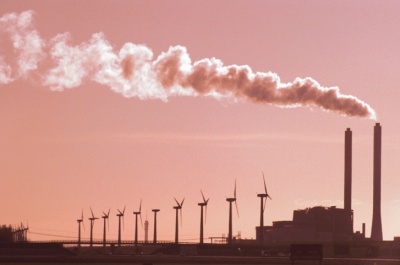 From the Editors of E/The Environmental Magazine
From the Editors of E/The Environmental Magazine
Dear EarthTalk: How is wind power faring in the U.S. now? Is more of it coming on line and becoming a larger percent of the grid? And what about some of the highly publicized efforts to build wind farms, such as in Cape Cod, Massachusetts. Has that been approved? -- Paul Howe, San Francisco, CA

If coal or natural gas were to be substituted to generate the electricity we now get from wind, it would put 28 million additional tons of carbon dioxide into the atmosphere every year. (Photo: Getty Images)
Clean and green wind energy is the new darling of alternative energy developers, and the U.S. industry has been surging the past three years, especially as developers take advantage of government incentives-in the form of the so-called Production Tax Credit (PTC)-for erecting turbines and connecting them to the grid.
The non-profit American Wind Energy Association (AWEA) reports that, in 2007 alone, total U.S. wind power capacity grew by a new record of 45 percent, injecting some $9 billion into the economy. These new installations provide enough electricity to power 1.5 million typical American homes while strengthening the nation's energy supply with clean, homegrown electricity.
According to AWEA, utility-grade wind power installations are now in operation across 34 U.S. states, generating more than 16,000 megawatts (MW) of electricity cumulatively-enough to power upwards of 4.5 million homes and to generate 45,000 new domestic jobs. But even with this growth, wind energy still accounts for just one percent of U.S. electricity supply. Continued growth apace with of recent years, though, should make it a major player in the American energy scene within a decade. President Bush himself recently suggested that wind has the potential to supply up to 20 percent of the nation's electricity.
Of course, the volatility of oil prices has helped wind energy gain its foothold. Once a wind farm is built, the fuel cost is essentially zero (as long as the wind blows), whereas fluctuating fossil fuel prices have made traditional power sources more costly and risky. Upping our reliance on wind power has also allowed us to lower our overall carbon footprint. If coal or natural gas were to be substituted to generate the electricity we now get from wind, it would put 28 million additional tons of carbon dioxide into the atmosphere every year. Wind power also saves water by not requiring the billions of gallons of water used to cool coal-fired power plants, an increasingly contentious issue in arid areas with limited access to fresh water.
As for the contentious Cape Wind project proposed for Nantucket Sound in Massachusetts, the federal agency in charge, the U.S. Minerals Management Service, is sifting through tens of thousands of public comments and expects to make a final decision on the project by next winter. But even if they give it the green light, extensive permitting demands and legal challenges will likely hold up construction for years.
AWEA thinks that 2008 can be as much of a growth year as 2007 if Congress extends the PTC program. The Senate has already approved extending the PTC for at least one more year, but the House has yet to bring it up for a vote. Meanwhile, wind energy proponents are pacing the halls of Congress trying to persuade their Representatives that what's good for the wind industry is good for America.
Governor Martin O'Malley recently sent the following letter to individuals who had provided comments to the Md. DNR regarding the
State's plan to allow commercial wind power development on public land in Maryland:
As you are aware, I recently announced my decision not to allow commercial wind power development on public land in Maryland.
I reached this position after reflecting seriously on why we acquired those conservation lands and after a full evaluation of the public input we received. I wish to thank you for participating in that decision-making process by providing your input.
While I fully support expanding renewable energy development in this state, including commercial generation of wind power, our public conservation lands are not the right place for that development. The citizens of Maryland trust us to protect these lands for the future and to manage those special places for their essential environmental, recreational, scenic and economic value.
I want to assure you that wind power is, and will continue to be an important part of the state’s Renewable Energy Portfolio. The Department of Natural Resources and the Maryland Energy Administration will be working together to find locations on public lands where small scale non-commercial wind power facilities can be located to supply on-site facility needs. In addition, I have asked the energy administration to assist, in any way possible, wind power projects on privately owned lands and offshore locations.
As you are aware, I recently announced my decision not to allow commercial wind power development on public land in Maryland.
I reached this position after reflecting seriously on why we acquired those conservation lands and after a full evaluation of the public input we received. I wish to thank you for participating in that decision-making process by providing your input.
While I fully support expanding renewable energy development in this state, including commercial generation of wind power, our public conservation lands are not the right place for that development. The citizens of Maryland trust us to protect these lands for the future and to manage those special places for their essential environmental, recreational, scenic and economic value.
I want to assure you that wind power is, and will continue to be an important part of the state’s Renewable Energy Portfolio. The Department of Natural Resources and the Maryland Energy Administration will be working together to find locations on public lands where small scale non-commercial wind power facilities can be located to supply on-site facility needs. In addition, I have asked the energy administration to assist, in any way possible, wind power projects on privately owned lands and offshore locations.
CONTACTS: American Wind Energy Association, www.awea.org; Cape Wind, www.capewind.org; U.S. Minerals Management Service, www.mms.gov.
GOT AN ENVIRONMENTAL QUESTION? Send it to: EarthTalk, c/o E/The Environmental Magazine, P.O. Box 5098, Westport, CT 06881; or e-mail: earthtalk (at) emagazine.com.


